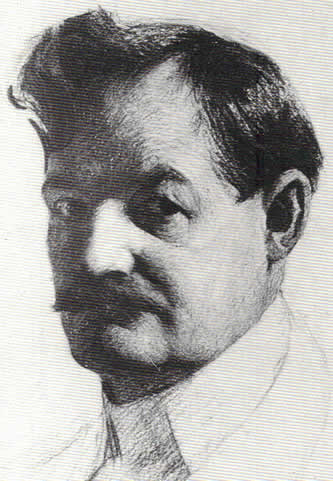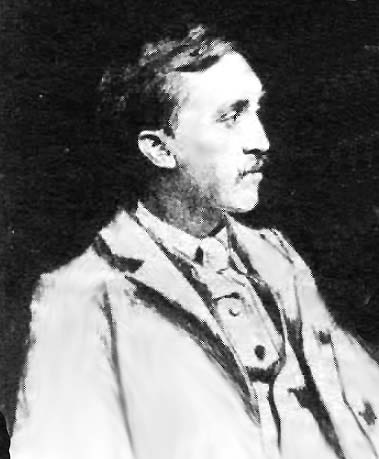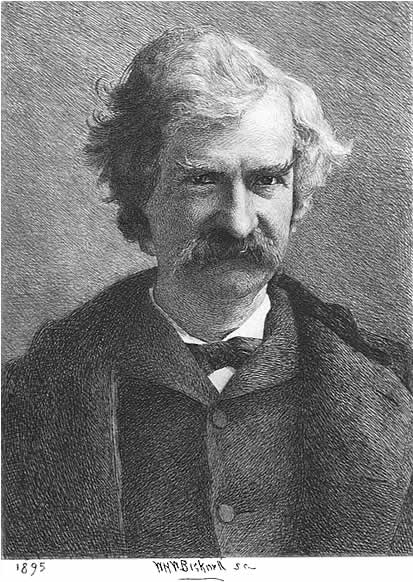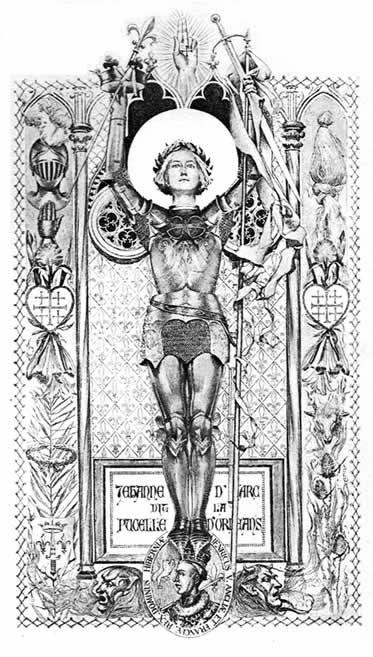Clemens's lifelong admiration for Joan peaked in August 1892 when he began
writing his history of her life with a bit of his own fiction added to the
story. By that time Joan had become a cult figure in both America and Europe.
Clemens later wrote that he based Joan's physical portrait on that of his
own daughter Susy. By March 1893 he had written 22 chapters and proposed
to end the story at the siege of Orleans. However, when Clemens negotiated
with Harper's Magazine to serialize the story, editor Henry Mills
Alden persuaded him to extend the story through Joan's trial and execution.
Clemens expanded and completed the book in February 1895 while living in
Paris. The finished volume totaled over 150,000 words and was divided into
three separate sections called "books" made up of 73 numbered
chapters and a conclusion. While living in Paris, Clemens also met with
American illustrator Frank Vincent Du Mond and arranged for Du Mond to illustrate
the work.
Harper's Magazine serialized Personal Recollections of Joan of
Arc beginning in the April 1895 issue and the series ran for thirteen
months, concluding in April 1896. Clemens received $9,382 for the story.
Clemens also mandated that the story should run without his name in order
for it to be considered a serious work and not a humorous tale. Thus the
name Sieur Louis De Conte, identified as Joan's page and secretary, was
assigned the authorship for an ancient manuscript with modern day translations
provided by a fictitious Jean François Alden. Mark Twain scholars
have observed that the name Sieur Louis De Conte featured the same initials
SLC as Samuel Langhorne Clemens and that translator Alden was the same surname
of editor Henry Mills Alden. Shortly after the magazine publication ended,
Harper and Brothers issued the work as a single volume book in May 1896
with Mark Twain's name on the spine and cover. It was one of three books
devoted to Joan of Arc that year -- the other two being Francis C. Lowell's
Joan of Arc published by Houghton, Mifflin and Company and Margaret
Oliphant's Jeanne d'Arc published by G. P. Putnam's Sons.
One of the earliest reviews of Mark Twain's version of the life of Joan
of Arc was written by William Peterfield Trent (b. 1862 - d. 1939) and appeared
May 1896 in Bookman magazine . Trent wrote that readers had been
able to detect Mark Twain's authorship of the book almost from the beginning
of the Harper series:
Dividing the Work
In an agreement between Harper and American Publishing Company,
dated December 31, 1896, American Publishing Company acquired the rights
to include The Personal Recollections of Joan of Arc in their 1899
uniform edition of Mark Twain's works. Under a second agreement dated November
11, 1898 Frank Bliss was allowed to manufacture new printing plates that
would immediately become the property of Harper and Brothers. By producing
a new set of plates in Hartford, Bliss could save transportation costs and
insurance involved in shipping the plates from New York.
In order to reconstruct the book in a size that would be uniform
in width with other volumes in the set which were shorter in length, Frank
Bliss divided Joan of Arc into two separate volumes which became
not only Volumes 17 and 18 of the uniform set, but also parts 1 and 2 of
the title work itself. Volume 17 concludes with Chapter 27 in the middle
of the section known as Book II. Volume 18 begins in the middle of the section
known as Book II with Chapter 28.
Refining the Work
Although Clemens had an opportunity to revise and refine his work for the
1899 uniform edition, there is little evidence to suggest he took an active
interest in doing so. No scholarly comparison of the 1899 uniform edition
to the original magazine serialization or Harper's first edition of the
book has been conducted. Production of the new 1899 plates also had the
potential to introduce inconsistencies into the texts that were the result
of typesetting errors.
|
Frank Bliss intended to correct any errors for subsequent printings
and hired Forrest Morgan (b. 1852 - d. 1924), a fastidious proofreader,
to weed out errors. Morgan, a former editor of the Hartford Travelers
Record and later an assistant librarian at Watkinson Library in
Hartford, read from a set of the Royal
Edition to mark errors.
Clemens was familiar with the work of Forrest Morgan in Travelers
Record. When Clemens wrote "Stirring Times in Austria"
in 1897 he quoted from a long passage he credited to Morgan to describe
the history of disunity in the Austro-Hungarian empire. "Stirring
Times in Austria" was published in Harper's Monthly in
March 1898 and is reprinted in Volume 22.
Morgan's 22-volume set of the Royal Edition with his annotations
is in the Beinecke Rare Book and Manuscript Library at Yale University,
a gift from William Lyon Phelps in 1922.
No extensive study of Morgan's notes for Joan of Arc has been
conducted.
|
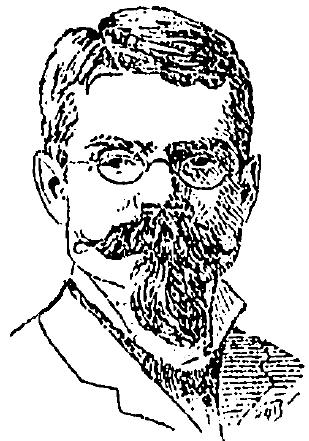
Forrest
Morgan, proofreader for the 1899 uniform edition, helped refine the
works for subsequent editions. |
.
How strange it is!--that almost invariably the artist remembers
only one detail -- one minor and meaningless detail of the personality of
Joan of Arc: to wit, that she was a peasant girl -- and forgets all the rest;
and so he paints her as a strapping middleaged fishwoman, with costume to
match, and in her face the spirituality of a ham. He is slave to his one idea,
and forgets to observe that the supremely great souls are never lodged in
gross bodies. ... The artist should paint her spirit -- then he could not
fail to paint her body aright. She would rise before us, then, a vision to
win us, not repel: a lithe young slender figure, instinct with "the unbought
grace of youth," dear and bonny and lovable, the face beautiful, and
transfigured with the light of that lustrous intellect and the fires of that
unquenchable spirit (Twain, 1904, p. 12).
Du Mond's more unattractive illustrations of Joan of Arc slowly
faded from public view and would not be available until Oxford University Press
published a facsimile of the first edition in 1996.
References
Budd,
Louis J. Mark Twain: The Contemporary Reviews. (Cambridge University
Press, 1999).
Emerson,
Everett. Mark Twain: A Literary Life. (University of Pennsylvania Press,
2000).
Fatout,
Paul, ed. Mark Twain Speaking. (University of Iowa Press, 1978).
"Frank
Dumond, 86, Painter, Teacher," The New York Times, 7 February
1951, p. 29.
Harmony
of Nature: The Art and Life of Frank Vincent DuMond, 1865-1951. (Lyme
Historical Society, 1990).
Leary,
Lewis, ed. Mark Twain's Correspondence with Henry Huttleston Rogers 1893-1909.
(University of California Press, 1969).
Maik,
Thomas A. A Reexamination of Mark Twain's Joan of Arc. (Edwin Mellen
Press, 1992).
Paine,
Albert Bigelow. Mark Twain: A Biography, 4-volume edition. (Harper
and Brothers, 1912).
Rasmussen,
R. Kent. Critical
Companion to Mark Twain, Volumes I and II. (Facts on File, 2007).
Twain,
Mark. Personal Recollections of Joan of Arc. Edition De Luxe. (American
Publishing Company, 1899).
_____.
Personal Recollections of Joan of Arc. (Oxford University Press, 1996).
_____.
"Saint Joan of Arc," Harper's Monthly Magazine, December
1904, pp. 2-12.

